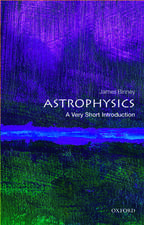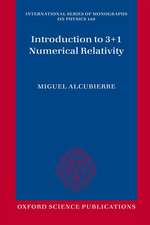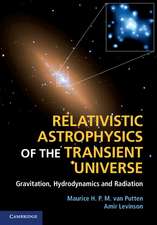Astrophysics in the Next Decade: The James Webb Space Telescope and Concurrent Facilities: Astrophysics and Space Science Proceedings
Editat de Harley A. Thronson, Massimo Stiavelli, Alexander Tielensen Limba Engleză Hardback – 11 feb 2009
As part of preparation to use JWST, a conference was held in Tucson, Arizona in 2007 that brought together astronomers from around the world to discuss the mission, other major facilities that will operate in the coming decade, and major scientific goals for them. This book is a compilation of those presentations by some of the leading researchers from all branches of astronomy. This book also includes a “pre-history” of JWST, describing the lengthy process and some of the key individuals that initiated early work on the concepts that would evolve to become the premier space observatory of the next decade.
| Toate formatele și edițiile | Preț | Express |
|---|---|---|
| Paperback (1) | 2099.14 lei 6-8 săpt. | |
| SPRINGER NETHERLANDS – 28 oct 2010 | 2099.14 lei 6-8 săpt. | |
| Hardback (1) | 2108.27 lei 6-8 săpt. | |
| SPRINGER NETHERLANDS – 11 feb 2009 | 2108.27 lei 6-8 săpt. |
Din seria Astrophysics and Space Science Proceedings
- 24%
 Preț: 1041.90 lei
Preț: 1041.90 lei - 18%
 Preț: 1211.74 lei
Preț: 1211.74 lei - 18%
 Preț: 1211.11 lei
Preț: 1211.11 lei - 18%
 Preț: 1241.42 lei
Preț: 1241.42 lei - 18%
 Preț: 1216.48 lei
Preț: 1216.48 lei - 18%
 Preț: 2482.38 lei
Preț: 2482.38 lei - 18%
 Preț: 943.88 lei
Preț: 943.88 lei - 18%
 Preț: 1232.26 lei
Preț: 1232.26 lei - 18%
 Preț: 1834.10 lei
Preț: 1834.10 lei - 24%
 Preț: 1033.36 lei
Preț: 1033.36 lei - 18%
 Preț: 1228.29 lei
Preț: 1228.29 lei - 18%
 Preț: 1218.69 lei
Preț: 1218.69 lei - 18%
 Preț: 944.19 lei
Preț: 944.19 lei - 24%
 Preț: 1043.61 lei
Preț: 1043.61 lei - 18%
 Preț: 943.25 lei
Preț: 943.25 lei - 18%
 Preț: 1237.80 lei
Preț: 1237.80 lei - 18%
 Preț: 1227.99 lei
Preț: 1227.99 lei - 18%
 Preț: 1834.58 lei
Preț: 1834.58 lei - 18%
 Preț: 1375.28 lei
Preț: 1375.28 lei - 18%
 Preț: 1217.23 lei
Preț: 1217.23 lei - 18%
 Preț: 1239.19 lei
Preț: 1239.19 lei - 18%
 Preț: 952.72 lei
Preț: 952.72 lei - 18%
 Preț: 1825.92 lei
Preț: 1825.92 lei - 18%
 Preț: 1825.27 lei
Preț: 1825.27 lei - 18%
 Preț: 1822.57 lei
Preț: 1822.57 lei - 18%
 Preț: 942.44 lei
Preț: 942.44 lei - 18%
 Preț: 955.25 lei
Preț: 955.25 lei - 18%
 Preț: 1837.57 lei
Preț: 1837.57 lei
Preț: 2108.27 lei
Preț vechi: 2571.07 lei
-18% Nou
Puncte Express: 3162
Preț estimativ în valută:
403.41€ • 421.19$ • 333.88£
403.41€ • 421.19$ • 333.88£
Carte tipărită la comandă
Livrare economică 05-19 aprilie
Preluare comenzi: 021 569.72.76
Specificații
ISBN-13: 9781402094569
ISBN-10: 1402094566
Pagini: 531
Ilustrații: XII, 519 p.
Dimensiuni: 155 x 235 x 25 mm
Greutate: 1 kg
Ediția:2009
Editura: SPRINGER NETHERLANDS
Colecția Springer
Seria Astrophysics and Space Science Proceedings
Locul publicării:Dordrecht, Netherlands
ISBN-10: 1402094566
Pagini: 531
Ilustrații: XII, 519 p.
Dimensiuni: 155 x 235 x 25 mm
Greutate: 1 kg
Ediția:2009
Editura: SPRINGER NETHERLANDS
Colecția Springer
Seria Astrophysics and Space Science Proceedings
Locul publicării:Dordrecht, Netherlands
Public țintă
ResearchCuprins
The James Webb Space Telescope.- Beyond the Hubble Space Telescope: Early Development of the Next Generation Space Telescope.- The Kuiper Belt and Other Debris Disks.- The Future of Ultracool Dwarf Science with JWST.- Transiting Exoplanets with JWST.- The Unsolved Problem of Star Formation: Dusty Dense Cores and the Origin of Stellar Masses.- Accretion Disks Before (?) the Main Planet Formation Phase.- Astrochemistry of Dense Protostellar and Protoplanetary Environments.- Extreme Star Formation.- Prospects for Studies of Stellar Evolution and Stellar Death in the JWST Era.- Origin and Evolution of the Interstellar Medium.- Astrophysics in the Next Decade: The Evolution of Galaxies.- The Co-Evolution of Galaxies and Black Holes: Current Status and Future Prospects.- The Intergalactic Medium at High Redshifts.- Observing the First Stars and Black Holes.- Baryons: What,When and Where?.- Observational Constraints of Reionization History in the JWST Era.- The Frontier of Reionization: Theory and Forthcoming Observations.
Notă biografică
Thronson’s current responsibilities include identification, assessment, and advocacy for advanced human/robotic programs at NASA Goddard Space Flight Center in coordination with other NASA Centers, industry, and the scientific community. Previously, while working at NASA Headquarters, he was responsible for selection and development of advanced technologies that will significantly enhance future science missions such as large astronomical observatories in space and robotic missions to Mars, other planets, and the Moon. He has also served as the program scientist for the Hubble Space Telescope (HST), the Spitzer Space Telescope (SIRTF), the James Webb Space Telescope (JWST), and the Stratospheric Observatory for Infrared Astronomy (SOFIA), among other missions. Over the past few years, he has served as senior scientist on a variety of long-range planning activities and led three NASA HQ teams that developed science and technology priorities for President George Bush’s Vision for Space Exploration. He received his Ph.D. in astrophysics in 1978 from the University of Chicago and has been a faculty member and on the senior staff of the Universities of Arizona and Wyoming, and the Royal Observatory, Edinburgh. He has published more than 100 research papers and co-edited 12 books.
Stiavelli obtained his PhD at the Scuola Normale Superiore of Pisa in 1986. He has been a postdoctoral researcher at Rutgers University and a fellow at the European Southern Observatory in Garching. He has held positions at the Scuola Normale Superiore of Pisa (1992-1995), at the European Space Agency in Baltimore (1995-2000), and at the Space Telescope Science Institute in Baltimore (since 2000). He is a member of the American Astronomical Society, of the American Association for the Advancement of Science, of the American Institute of Aeronautics and Astronautics and of the International Astronomical Union. He hasserved and chaired several NASA committees and is a member of the Science Working Group of the James Webb Space Telescope. He has authored or coauthored 83 papers on professional journals and 146 technical reports and other publications.
Tielens is a senior scientist at NASA Ames Research Center and a professor of astrophysics at the Kapteyn Institute in the Netherlands. Prior to this, he was associated with the astronomy department of the University of California in Berkeley and the Dutch Space Agency, SRON. He is the project scientist of HIFI the heterodyne instrument that will fly on the Herschel Space Observatory and the coordinator of the 'Molecular Universe' an interdisciplinary network on interstellar chemistry. He has published extensively on various aspects of the physics and chemistry of the interstellar medium of galaxies.
Stiavelli obtained his PhD at the Scuola Normale Superiore of Pisa in 1986. He has been a postdoctoral researcher at Rutgers University and a fellow at the European Southern Observatory in Garching. He has held positions at the Scuola Normale Superiore of Pisa (1992-1995), at the European Space Agency in Baltimore (1995-2000), and at the Space Telescope Science Institute in Baltimore (since 2000). He is a member of the American Astronomical Society, of the American Association for the Advancement of Science, of the American Institute of Aeronautics and Astronautics and of the International Astronomical Union. He hasserved and chaired several NASA committees and is a member of the Science Working Group of the James Webb Space Telescope. He has authored or coauthored 83 papers on professional journals and 146 technical reports and other publications.
Tielens is a senior scientist at NASA Ames Research Center and a professor of astrophysics at the Kapteyn Institute in the Netherlands. Prior to this, he was associated with the astronomy department of the University of California in Berkeley and the Dutch Space Agency, SRON. He is the project scientist of HIFI the heterodyne instrument that will fly on the Herschel Space Observatory and the coordinator of the 'Molecular Universe' an interdisciplinary network on interstellar chemistry. He has published extensively on various aspects of the physics and chemistry of the interstellar medium of galaxies.
Textul de pe ultima copertă
NASA’s James Webb Space Telescope (JWST), planned for operation in about five years, will have the capability to investigate – and answer – some of the most challenging questions in astronomy. Although motivated and designed to study the very early Universe, the performance of the observatory’s instruments over a very wide wavelength range will allow the world’s scientific community unequaled ability to study cosmic phenomena as diverse as small bodies in the Solar System and the formation of galaxies. As part of preparation to use JWST, a conference was held in Tucson, Arizona in 2007 that brought together astronomers from around the world to discuss the mission, other major facilities that will operate in the coming decade, and major scientific goals for them. This book is a compilation of those presentations by some of the leading researchers from all branches of astronomy. This book also includes a "pre-history" of JWST, describing the lengthy process and some of the key individuals that initiated early work on the concepts that would evolve to become the premier space observatory of the next decade.
Caracteristici
must-have volume discussing the astrophysics to be enabled by James Webb Space Telescope and concurrent facilities during the next decade














